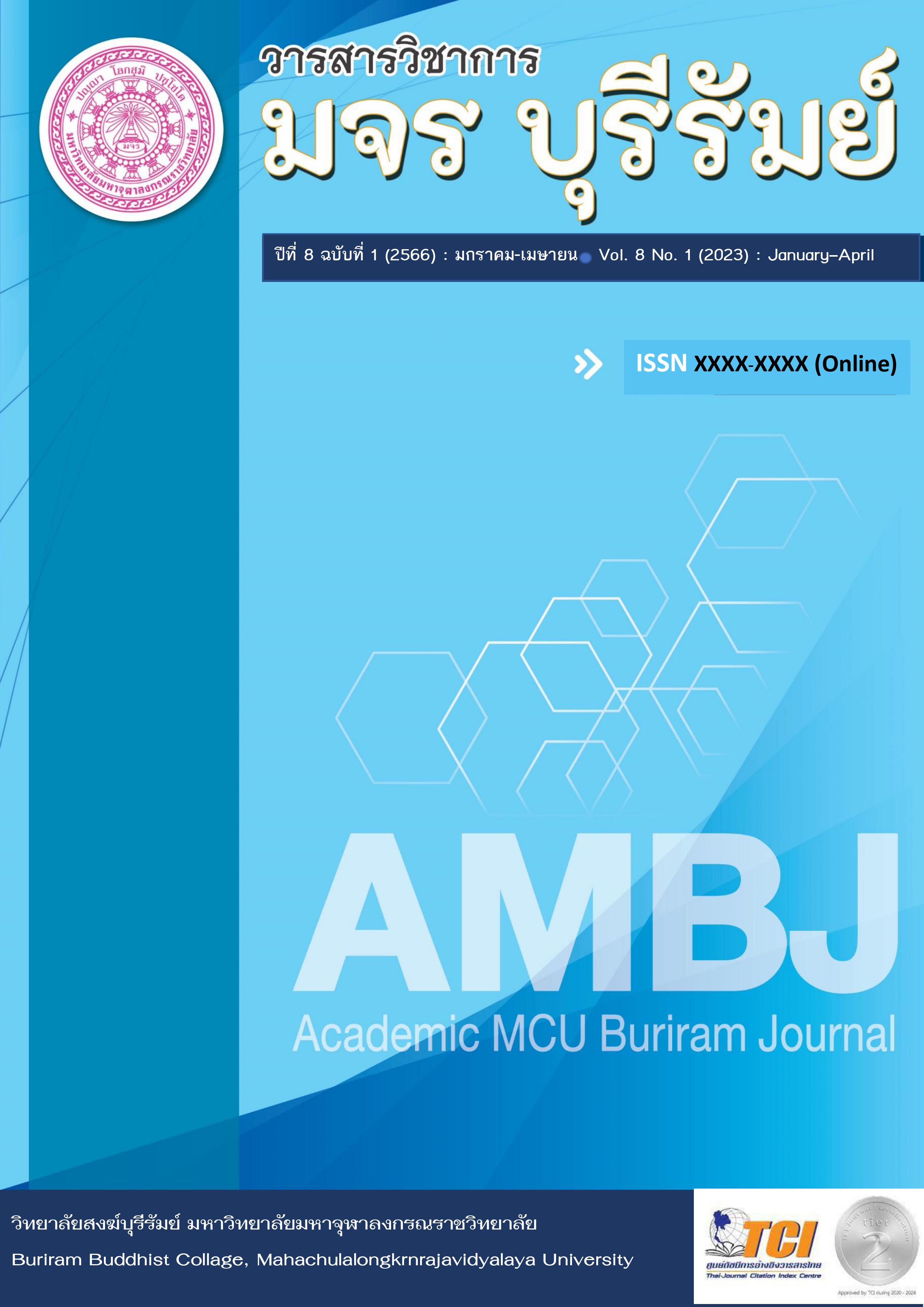An Integrated Model of the Sappãya Principles to Promote Self-Reliance of the Elderly in Doi Saket Subdistrict Municipality, Doi Saket District Chiang Mai Province
Keywords:
Sappàya, Self-Reliance, ElderlyAbstract
The purpose of this research were: 1) to examine the Sappàya principle as found in Theravada Buddhist scriptures, 2) to investigate the concept of Sappàya and Self-Reliance of the Elderly, and 3) to propose an integrated model of the Sappàya. The Sappàya principle was used to analyze field data collected from 31 elderly people and their relatives to learn more about how to encourage elder independence.
The research results found that:
1. The Sappàya principle refers to things that are comfortable and supportive in meditating with good results. It consists of seven conditions things viz., 1) suitable abode, 2) suitable resort, 3) suitable speech, 4) suitable person, 5) suitable food, 6) suitable climate and 7) suitable posture. In this study, the concept of Sappàya refers to the convenience of living for the elderly. The principle of self-sufficiency entails not being a burden to others.
2. The Sappàya concept refers to the ease with which the elderly can live. Being self-sufficient means not relying on others for assistance. It may also be able to rely on other people. Buddhism's self-reliance teachings refer to Dhamma, which serves as reliance. Dhamma fosters a refuge morality that allows for independence.
3. A model of integrating Sappàya principles to promote elderly self-sufficiency in Doi Saket Subdistrict Municipality, Chiang Mai Province. It was discovered that the integration model should begin at the elderly's home because the home is considered the center of the entire family. As a result, home improvements do not necessitate extensive structural changes. It should only be replaced in areas prone to frequent accidents, such as stairwells, which should have handrails on both sides, should not be carpeted, and should not have obstacles in the corridor, among other things. The bedroom should be well ventilated, and there should be a light beside the bed. There are handrails, and the color should be obvious. Their restrooms should be wheelchair accessible. Instead of scooping it up with a bowl, they should practice using the shower. Their front doors should be sliding and unlocked from the outside. Temples, parks, markets, and government buildings should all be improved or added to safe facilities with handrails.
References
กระทรวงวัฒนธรรมฝ่ายประมวลเอกสารและจดหมายเหตุ. (2550). กรุงเทพมหานคร: ม.ป.ท.
ชวลิต สวัสดิ์ผล และคณะ. (2559). การดูแลผู้สูงอายุที่อยู่ในสภาวะพึ่งพิงในพื้นที่ภาคตะวันออกเฉียงเหนือของไทย. รายงานวิจัย. กรุงเทพมหานคร: มหาวิทยาลัยสวนดุสิต.
ชณิตา ประดิษฐสถาพร และคณะ. (2555). สุขภาวะจิตของผู้สูงอายุไทยตามแนววิถีพุทธ. รายงานการวิจัย สมาคมพยาบาลสาธรณสุขไทย. วารสารพยาบาลสาธารณสุข, 26(1), 20.
ธีรโชติ เกิดแก้ว. (2547). หลักการจัดระเบียบเพื่อความสมดุลของครอบครัว/สังคม. วารสาร มจร.วิชาการ, 8(14), 80.
พระครูปฐมวรวัฒน์ และคณะ. (2556). ปัจจัยจิตสังคมที่เกี่ยวกับการปรับพฤติกรรมต่อวิถีชีวิตของผู้สูงอายุ.
พระมหากฤษฎา กิตฺติโสภโณ และคณะ. (2561). ผู้สูงอายุต้นแบบตามแนวพุทธ กรณีศึกษาหลวงพ่อวัดบางเบิด จังหวัดประจวบคีรีขันธ์. วารสารวิชาการสถาบันพัฒนาพระวิทยากร, 1(2), 3.
พระพุทธโฆสเถระ. (2548). คัมภีร์วิสุทธิมรรค. แปลและเรียบเรียงโดย สมเด็จพระพุฒาจารย์ (อาจ อาสภ มหาเถร).
พระพุทธโฆสเถระ. (2554). คัมภีรวิสุทธิมรรค. สมเด็จพระพุฒาจารย (อาจ อาสภมหาเถร), แปลและ เรียบเรียง. กรุงเทพมหานคร: ธนาเพรส.
มหาจุฬาลงกรณราชวิทยาลัย. (2539). พระไตรปิฎกภาษาไทย ฉบับมหาจุฬาลงกรณราชวิทยาลัย. กรุงเทพมหานคร: โรงพิมพ์มหาจุฬาลงกรณราชวิทยาลัย.
มาสริน ศุกลปักษ์. กรัณฑรัตน์ บุญช่วยธนาสิทธิ์. (2560). องค์ประกอบบ้านสุขภาพตามแนวคิดสภาวะพฤฒพลังของผู้สูงอายุ: การทบทวนวรรณกรรมอย่างเป็นระบบ. วารสารวิจัยทางวิทยาศาสตร์สุขภาพ, 11(ฉบับพิเศษ), 5.
สำนักงานหลักประกันสุขภาพแห่งชาติ (สปสช.). (2559). คู่มือระบบการดูแลระยะยาวด้านสาธารณสุขสำหรับผู้สูงอายุที่มีภาวะพึ่งพิงในพื้นที่ (Long Term Care). กรุงเทพมหานคร: สำนักงานหลักประกันสุขภาพแห่งชาติ (สปสช.).
สำนักอนามัยสิ่งแวดล้อมที่เหมาะสมกับผู้สูงอายุ. (2558). การจัดสภาพแวดล้อมที่เหมาะสมกับผู้สูงอายุ. กรุงเทพมหานคร: สำนักงานกิจการโรงพิมพ์องค์การสงเคราะห์ทหารผ่านศึก.
สุนทรี พัวเวส. (2551). ความรู้เกี่ยวกับเรื่องผู้สูงอายุ. พิมพ์ครั้งที่ 2. กรุงเทพมหานคร: สำนักส่งเสริมและพิทักษ์ผู้สูงอายุ.
W.C. Allee, O. Park, A. E. Emerson, et al. (1949). Principles of animal ecology. (Philadelphia: W.B. Saunders, Co.).
Downloads
Published
How to Cite
Issue
Section
License
Copyright (c) 2023 Academic MCU Buriram Journal

This work is licensed under a Creative Commons Attribution-NonCommercial-NoDerivatives 4.0 International License.
ทัศนะและความคิดเห็นที่ปรากฏในบทความวารสารฉบับนี้ถือเป็นความรับผิดชอบของผู้เขียนบทความนั้น ไม่ถือเป็นทัศนะและความรับผิดชอบของบรรณาธิการ





